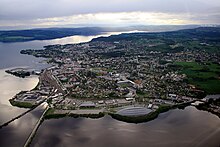|
Innlandet
Innlandet is a county in Norway.[4] It was created on 1 January 2020[5] with the merger of the old counties of Oppland and Hedmark (the municipalities of Jevnaker and Lunner were transferred to the neighboring county of Viken on the same date). The new county has an area of 52,113 square kilometres (20,121 sq mi), making it the largest county in Norway after Troms og Finnmark was split up in 2024.[6] The region was known as Opplandene or Opplanda since the middle ages. Historically part of Akershus, Oplandene County existed from 1757 to 1781, when it was divided into Christians County and Hedemarken County, also known as Western and Eastern Oplandene. In 1919 the two counties were renamed Oppland and Hedmark, and in 2020 they were again merged under the name Innlandet (with the exception of Jevnaker and Lunner municipalities, which went to the new county of Viken). This present name is a newly constructed name with no historical basis as a subdivision name and was recommended not to be used by the Norwegian Language Council.[7] It translates to "The Inland". The county covers approximately 17% of the total area of the mainland area of Norway. It stretches from Akershus, Buskerud and the Oslo region in the south to Trøndelag county in the north. In the northwest, the county borders Møre og Romsdal and the Vestland county in the west. To the east the county borders the Swedish counties of Jämtland, Värmland and Dalarna. The northern and western areas of the county are dominated by the mountainous areas Rondane, Dovrefjell and Jotunheimen. The Galdhøpiggen mountain is located within the Innlandet part of Jotunheimen and at 2,469 m (8,100 ft) it is the tallest mountain in Norway. The eastern and southern areas of the county are mainly made up of forests and agricultural land. Mjøsa, Norway's largest lake, is located in the southern end of Innlandet, and Glomma the longest river in Norway also flows through the county. Agriculture and forestry are two important industries in the county with approximately 20% of Norway's agricultural production[8] and about 40% of timber.[9] The 1994 Winter Olympics were held at Lillehammer, the second-largest city in Innlandet county. MunicipalitiesInnlandet County has a total of 46 municipalities:[10][11]
Settlements   Most of the settlements in Innlandet are fairly small. As of 1 January 2020 Hamar is the largest with a population of 28,434.[12] Lillehammer, Gjøvik, Elverum, Kongsvinger and Brumunddal are the only other cities with populations above 10,000. However, Raufoss, Moelv, Vinstra, Fagernes and Otta also have city status. Churches and parishesThe Church of Norway Diocese of Hamar is composed of the entirety of Innlandet plus Jevnaker and Lunner in neighboring Akershus county. GeographyMountains
GovernmentA county (fylke) is the chief local administrative area in Norway. The whole country is divided into 11 counties. A county is also an election area, with popular votes taking place every 4 years. In Innlandet, the government of the county is the Innlandet County Municipality. It includes 57 members who are elected to form a county council (Fylkesting). Heading the Fylkesting is the county mayor (fylkesordfører). Since 2020, the Innlandet County Municipality has been led by Even Aleksander Hagen, the county mayor. The county also has a County Governor (Statsforvalteren) who is the representative of the King and Government of Norway. Knut Storberget is the current County Governor of Innlandet. The offices for the county governor are located in Lillehammer.[13][6] See also
References
External linksWikimedia Commons has media related to Innlandet. |
|||||||||||||||||||||||||||||||||||||||||||||||||||||||||||||||||||||||||||||||||||||||||||||||||||||||||||||||||||||||||||||||||||||||||||||||||||||||||||||||||||||||||||||||||||||||||||||||||||||||||||||||||||||||||||||||||||||||||||||||||||||||||||||||||||||||||||||||||||||||||||||||||||||||||||||||||||||





